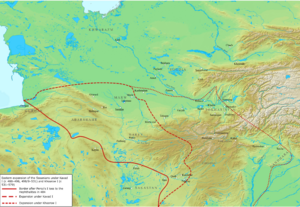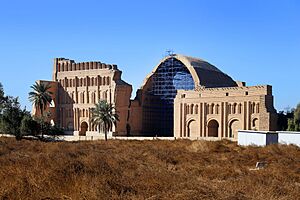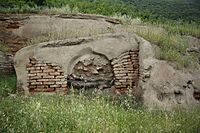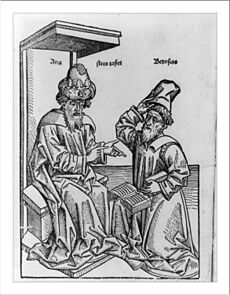Khosrow I facts for kids
Quick facts for kids Khosrow IXosrōe 𐭧𐭥𐭮𐭫𐭥𐭣𐭩 |
|
|---|---|
| King of Kings of Iran and non-Iran | |
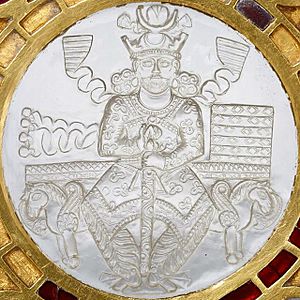
Khosrow I on an ornamental plate in BnF Museum
|
|
| Shahanshah of the Sasanian Empire | |
| Reign | 13 September 531 – February 579 |
| Predecessor | Kavad I |
| Successor | Hormizd IV |
| Born | 512–514 Ardestan, Sasanian Empire |
| Died | February 579 (aged 65–67) Ctesiphon, Sasanian Empire |
| Spouse | Khazar princess |
| Issue |
|
| House | House of Sasan |
| Father | Kavad I |
| Mother | Ispahbudhan noblewoman |
| Religion | Zoroastrianism |
Khosrow I (also known as Anushirvan, meaning "the Immortal Soul") was a powerful king of the Sasanian Empire in Iran. He ruled from 531 to 579 CE. Khosrow was the son and successor of Kavad I. He is remembered as one of the greatest Sasanian kings because he made many important changes to the empire.
When Khosrow became king, his empire was at war with the Byzantine Empire. He quickly made a peace treaty with them in 532, called the Perpetual Peace. This allowed him to focus on making his own country stronger. He made big changes to the way the government worked, the army, and how taxes were collected. He also built many new cities and important structures.
Khosrow was very interested in learning and new ideas. During his time, art and science grew a lot in Iran. He was known for being wise and fair. By the end of his rule, the Sasanian Empire was very large, stretching from Yemen in the west to Gandhara in the east. His son, Hormizd IV, became king after him.
Contents
About Khosrow's Name
Khosrow's name is spelled in different ways, like Khosrau or Chosroes. His original name in Middle Persian was Husraw, which means "he who has good fame."
He was also widely known by his special title, Anushirvan. This means "the Immortal Soul." He got this name after he died to help people tell him apart from another king named Khosrow II. This title also showed that he was a good king who helped his country become rich and strong. People also called him Dādgar ("Dispenser of Justice") and 'Adel ("the Just").
Khosrow's Early Life
Khosrow I was born around 512 to 514 CE in a town called Ardestan in central Iran. His father was Kavad I, the ruling Sasanian king. Khosrow's mother was a princess from the House of Ispahbudhan, one of the most important noble families in the Sasanian Empire. This family was so respected that they were seen as "kin and partners of the Sasanians."
Like other noble children, Khosrow started school between the ages of five and seven. He learned to write and studied religious texts. He also trained in riding, archery, and polo, which were important skills for a future leader.
Early Challenges
Around 520 CE, Khosrow's father, Kavad, wanted to make sure Khosrow would become king. Khosrow had rival brothers and a religious group called the Mazdakites who could challenge his claim to the throne. Kavad suggested that the Byzantine Emperor Justin I adopt Khosrow. The Byzantines were worried this might give Khosrow a claim to their throne later. So, they offered to adopt him as a "barbarian" rather than a Roman. These talks failed, and Khosrow felt insulted.
Kavad had originally supported the Mazdakite movement, which believed in sharing wealth and property. This movement caused problems for the rich nobles and religious leaders. Kavad used it to reduce their power. But by the 520s, he no longer needed the Mazdakites. So, he stopped supporting them. Khosrow then took action to stop the Mazdakites. The details of how they were stopped are not clear, but it was a harsh end for the movement.
Becoming King
Making Peace with Byzantines
In 531 CE, Khosrow's father, Kavad, died while the Iranian army was fighting the Byzantines. Khosrow became king. Because his position at home was not yet fully secure, he wanted to make peace with the Byzantines. The Byzantine Emperor Justinian I was also busy trying to get back parts of the old Roman Empire in the west.
So, they made a deal. Justinian agreed to pay Khosrow 11,000 pounds of gold. This money was supposedly to help defend the Caucasus mountain passes from northern tribes. In return, the Byzantines would move their army base from Dara to Constantina. Both sides agreed to help each other if needed. After some back and forth, they finally agreed to exchange captured forts and allow Iberian rebels to return home safely. This agreement was called the "Eternal Peace of 532."
Securing His Rule
Early in his reign, Khosrow had to deal with his older brother, Kawus, who was a governor. Kawus had support from the Mazdakites and claimed he should be king because he was older. Khosrow's forces defeated Kawus and brought him to the capital, Ctesiphon. Kawus refused to ask for forgiveness and was killed. Khosrow was said to be sad about having to kill his brother.
Khosrow also faced a plot from his uncle, Bawi, and other nobles. They wanted to overthrow Khosrow and put his cousin, Kavad (the son of Khosrow's brother Jamasp), on the throne. When Khosrow found out, he had all his brothers and their children, along with Bawi and the other nobles involved, killed. He also ordered the death of young Kavad, who was being raised away from the court. However, Kavad's guardian disobeyed and raised him in secret. Kavad later fled to the Byzantine Empire.
Khosrow's Reforms
Khosrow I is seen as a "philosopher king" in the Sasanian Empire. When he became king, he didn't give power back to the old noble families or priests. Instead, he made the government more centralized and stronger. His rule is considered one of the most successful times for the Sasanian Empire. The peace with the Byzantines in 531 allowed Khosrow to focus on improving his empire from the inside.
His changes led to a stronger central government and reduced the power of the big noble families. The army was also reorganized, becoming more professional and directly controlled by the king, not by local nobles. Tax changes gave the empire a steady income, which helped pay for military campaigns and the government.
Tax Changes
Khosrow's tax reforms were very important. Before his rule, much of the land was owned by a few powerful families who didn't pay taxes and collected them from others.
After the Mazdakite movement caused confusion about land ownership, Khosrow surveyed all the land in the empire. He started taxing all land under a single system. Taxes that used to go to local noble families now went directly to the central government. This new fixed tax system gave the government a more stable income.
The new system calculated taxes based on things like water rights for each property. Lands with date palms and olive trees were taxed based on the number of producing trees. These tax changes were the foundation for other reforms in the government and military.
Government Changes
Khosrow's biggest government change was creating a new social class called the dehqans. Before, there were only three main classes: priests, nobles, and common people. The dehqans were small landowners, considered a lower type of nobility.
Khosrow chose honest government officials based on their trustworthiness, rather than just using corrupt nobles. The dehqans were preferred because they were often more loyal to the king. The rise of the dehqans became the backbone of the empire. They now owned most of the land and held many positions in local government.
This reduction in power for the great noble families helped the empire. Before, each great family ruled a large area and acted like their own king. The title "Shahanshah" (King of Kings) came from this system. With the nobles' power reduced, more power and taxes went to the central government.
Military Changes
Khosrow made big changes to the military, making the Iranian army able to fight long wars and on many fronts. Before Khosrow, the army relied on feudal lords to provide soldiers and cavalry. Each noble family would bring their own army when the king called. This system was replaced by the new dehqan class, who were paid and equipped by the central government.
The main part of the Sasanian army was the Aswaran cavalry (heavy cavalry). Before, only nobles could join this elite cavalry, which limited the number of trained soldiers. Now that the dehqan class was considered nobility, they could join the cavalry, greatly increasing its size.
Khosrow also divided the empire into four military districts, each with its own general (called a spahbed). This new system made the military more efficient and helped manage the vast, diverse empire better.
Soldier's Equipment
During Khosrow's reign, a list of equipment for the aswaran cavalry was made. It included:
- A helmet
- Neck protection (gorget)
- Chain mail shirt
- Lamellar coat or cuirass (body armor)
- Leg armor
- Gauntlets (gloves for armor)
- Sword
- Shield
- Two bows with spare strings
- 30 arrows
- Axe or mace
- Horse armor
This shows that horses were still fully armored, and heavy cavalry tactics were important for the Sasanian army.
Military Campaigns
War with the Byzantine Empire (540–562)
In 539 CE, Khosrow looked for a reason to go to war with the Byzantines again. He accused Justinian of trying to bribe an Arab ruler and encouraging Huns to attack Iran. The Ghassanids, who were allies of the Byzantines, also attacked Khosrow's allies and took riches. Khosrow's requests for the return of these riches were ignored. These events, along with encouragement from the Ostrogoths and unhappy Armenians in Byzantine territory, led Khosrow to restart the war. Justinian's wars in North Africa and Italy also made Khosrow think it was a good time to attack.
Invasion of Syria
In May 540 CE, Khosrow invaded Byzantine lands. He captured and sacked the city of Sura. He then threatened Hierapolis, which paid him silver to leave it alone. Khosrow then attacked and sacked the city of Antioch, a major city.
Justinian asked for peace, and a treaty was made. The Iranians would leave Byzantine lands in return for a payment of gold. However, Khosrow continued to demand tribute from other Byzantine towns. Justinian then ended the truce and prepared his army.
Lazic War
In 541 CE, Khosrow brought his army north to Lazica because the Lazic king asked for help against the Byzantines. Khosrow's forces captured the fortress of Petra and made Lazica a protectorate (a country controlled by Iran).
Meanwhile, the Byzantine general Belisarius attacked the city of Nisibis in Mesopotamia. He couldn't capture it and was called back. After some successful battles in Armenia, Khosrow attacked Syria again. He besieged Edessa, but the city was well defended and he had to retreat.
In 545, the two empires agreed to a five-year truce. But three years later, a rebellion against Iranian control broke out in Lazica. The Byzantines sent an army to help, ending the truce and restarting the Lazic War.
Finally, in 562, a Fifty-Year Peace Treaty was signed. The Iranians agreed to leave Lazica in return for annual gold payments from the Byzantines. This treaty had 12 main points, including rules about trade, ambassadors, defectors, and not building new forts on the border.
War in the East
With peace in the west, Khosrow could now focus on the Hephthalite Empire in the east. The Hephthalites had caused problems for the Sasanians before. Khosrow made an alliance with the Göktürks, a Turkic people. In 557, they launched a two-sided attack on the Hephthalites, who were not well organized.
The Hephthalite Empire was destroyed. Their king and some of his men fled to Sasanian territory for safety. The Turkic leader made a new Hephthalite king, but Khosrow didn't like this. He marched to the border and made a new alliance with the Turks. This alliance made the new Hephthalite king a vassal (a ruler under the Sasanian king). The Oxus River became the border between the Sasanian and Turkic empires.
However, friendly relations between the Turks and Sasanians didn't last long. Both wanted to control the Silk Road trade. In 562, Khosrow defeated the Hephthalites again and stopped the threat from the Turks.
Campaign in Yemen
In 522 CE, before Khosrow was king, a group from Ethiopia attacked the Himyarite Kingdom in southern Arabia. The local Arab leader asked the Sasanians for help. Later, another Ethiopian force took control of Yemen.
In 531, the Byzantine emperor suggested that the Ethiopians in Yemen stop Sasanian trade with India. This didn't happen. After the Ethiopian leader died, one of his sons, Ma'd-Karib, asked Khosrow for help. Khosrow sent a small fleet and army under commander Wahrez to remove the current king of Yemen. After capturing the capital city, Ma'd-Karib's son was made king.
Because the Byzantines didn't help the Yemenite Arabs, Khosrow was able to help Ma'd-Karib. This made Yemen a part of the Sasanian Empire.
War with the Byzantine Empire (572–591)
When Justinian died in 565, Justin II became the new Byzantine emperor. In 555, a Sasanian governor in Armenia built a fire temple and killed a popular Armenian leader. This caused a revolt and the capture of the city of Dvin in 572. Justin II used this revolt as an excuse to stop paying Khosrow the annual payments, ending the 51-year peace treaty.
Khosrow tried to avoid another war and sent a diplomat to Constantinople, but Justin refused to listen. A Byzantine army then attacked Sasanian territory.
In 573, Khosrow sent an army to invade Syria. He also led an army to Dara, capturing the city after four months. Justin II reportedly became very upset after these Byzantine losses and gave up his throne.
Tiberius became the new emperor in 578. Khosrow invaded Armenia again and was initially successful. But soon, the Byzantines gained more local support. Khosrow then sent a large army, including allies, to attack areas in Syria. One of Khosrow's generals, Tamkhosrau, tricked the Byzantine commander Maurice and plundered other cities.
However, the war turned again when the new Byzantine commander Maurice captured many Sasanian settlements. The Armenian revolt ended when Khosrow offered them forgiveness and brought them back into the Sasanian Empire. Peace talks started again, but they ended suddenly with Khosrow's death in 579. His son, Hormizd IV, became king.
Religious Policy
Khosrow, like other Sasanian rulers, followed Zoroastrianism, the main religion of Iran. By the 5th century, Sasanian kings understood the importance of religious minorities like Jews and Christians. They tried to treat everyone fairly under the law. Christians in the Sasanian Empire even had a leader called the "Catholicos of Iran."
Sasanian kings usually only persecuted other religions if it was important for political reasons. Khosrow also had to be careful. He liked the leader of the Church of the East, Aba I, and wanted to protect him from Zoroastrian priests. However, Aba was accused of working with the Byzantines during the war, which was a serious charge. So, Aba was removed from his position but not killed.
Khosrow even had good relations with Gregory, a general from an important noble family, who had become a Christian. This caused problems with the court, who wanted Khosrow to punish him. Khosrow was forced to have Gregory removed and imprisoned, and later, Gregory was executed.
Khosrow did act quickly and harshly against people whose beliefs or practices went against the main Zoroastrian religion. This was because religious differences could upset the political order, as seen with the Mazdakites. According to some writings, Khosrow had nobles who practiced unusual beliefs executed. He also banished other groups, possibly Manichaeans, from Iran. This was to prevent religious groups from causing political trouble again.
Buildings and Projects
Khosrow is known for ordering many public works projects during his long rule. These included bridges, roads, dams, and walls. To protect the borders of Iran, Khosrow had a series of walls built and strengthened around his empire, similar to the Great Wall of China. He built them on four sides of the empire.
- In the east, he ordered the building of the Great Wall of Gorgan to stop attacks from nomadic tribes.
- In the northwest, he strengthened the Derbent Wall to protect against tribes like the Alans and Khazars.
- Another wall was built in the southwest, called the war-i tāzigān ("wall of the Arabs").
- He may have also built another wall in the northeast, the Wall of Tammisha.
Besides defense structures, Khosrow also created a large canal system called the Nahrawan Canal. His most famous building was the palace he built at Ctesiphon, known as the Taq-e Kasra. This palace, though ruined today, shows the amazing architecture of the empire.
After he sacked Antioch in 540, Khosrow built a new city for the captured people near Ctesiphon. It was called Weh-andīōg-husraw ("Khosrow's Better Antioch"). This city had public baths and a hippodrome (a stadium for chariot races). Christians living there were given freedom of religion. The city was also known as Rumagan ("Town of the Greeks").
-
Remains of the Great Wall of Gorgan
Coins
Khosrow's rule brought a new strong period for the Sasanian Empire. On his special coins, he had messages like "Iranians have become fearless" and "Iranians became strong."
The Philosopher King

Khosrow I was admired in Iran and other places for his good character, virtues, and knowledge of Greek philosophy. Some Romans even called him a true "philosopher king."
Khosrow I was a great supporter of philosophy and learning. He was very learned in philosophy and studied with wise teachers. He once said: "We looked at the customs of our ancestors, but to find the truth, we also studied the customs of the Romans and Indians. We accepted what seemed reasonable and good, not just what we liked. We didn't reject anyone because they had a different religion or came from a different people."
Khosrow I welcomed scholars from the Eastern Roman Empire when their schools were closed. He was very interested in Indian philosophy, science, math, and medicine. He sent many gifts to the Indian court and asked them to send philosophers to teach in his court. Khosrow had many texts translated from Greek, Sanskrit, and Syriac into Middle Persian. The Greek scholars he welcomed called him "Plato's Philosopher King" because of his interest in Platonic philosophy. Historians say Khosrow I was "certainly one of the most efficient and best kings that the Iranians have ever had."
During his reign, Greek, Iranian, Indian, and Armenian learning traditions came together in the Sasanian Empire. This led to important advances, like the creation of the bimaristan, which were early hospitals that separated patients based on their illness. Greek medicine combined with Iranian and Indian traditions led to big improvements in healthcare. This flow of knowledge created a "renaissance" (a period of great growth in art and learning) during Khosrow's time.
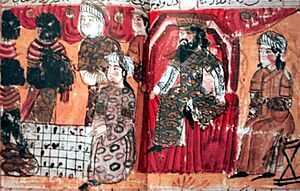
Khosrow also enjoyed intellectual games like chess and backgammon. These games showed the friendly relationship between Khosrow and a "great king of India." The Indian king's chief minister invented chess as a fun challenge for King Khosrow. The Indian ruler sent the game with a letter that said: "Since you are the King of Kings, your wise men should be wiser than ours. Either you explain this game of chess, or you send us money and tribute." Khosrow's chief minister successfully figured out how to play chess. In return, he created the game of backgammon and sent it to the Indian court with the same message. The Indian king could not solve the riddle and had to pay tribute.
Academy of Gondishapur
Khosrow I greatly expanded the Academy of Gondishapur, a famous learning center in the city of Gundeshapur. This academy brought together studies in philosophy, medicine, physics, poetry, and astronomy. It was built to provide a place for Greek scholars to study and share their knowledge. Gundeshapur became a key place where Greek and Indian sciences mixed with Iranian and Syriac traditions. This mix of cultures and ideas helped lead to modern studies.
Legacy
Khosrow's achievements were very successful and helped make the Sasanian Empire stronger and more centralized. However, these changes did not last long after his death. Local officials and powerful noble families, who had lost power, quickly started to regain it.
Khosrow's reign had a big impact on later Islamic culture and government. Many of his policies and reforms were adopted by the Islamic nation as it grew from a loose group of states into a strong empire.
Many Islamic writings were inspired by Khosrow I's rule. During his reign, the Silk Road trade route between ancient China, India, and the western world grew. Some historians believe Khosrow's many wars were partly to gain control over this important trade route.
Family tree
| Kavad I (ruled 488–496, 498–531) |
|||||||||||||||||||||||||||||||||||||||||||||||||||||||||||||||
| Kawus |
Zamasp |
Xerxes | Khosrow I (ruled 531–579) |
||||||||||||||||||||||||||||||||||||||||||||||||||||||||||||
| Shapur | Kavad | ||||||||||||||||||||||||||||||||||||||||||||||||||||||||||||||
| Anushzad | Hormizd IV (ruled 579–590) |
Yazdandad | |||||||||||||||||||||||||||||||||||||||||||||||||||||||||||||




